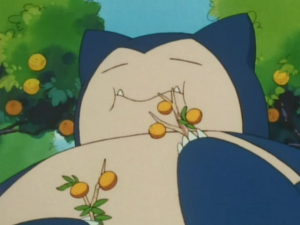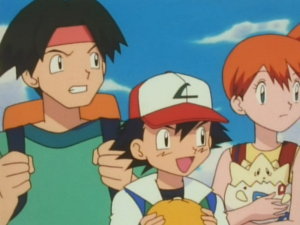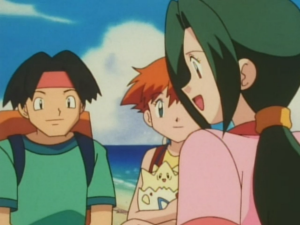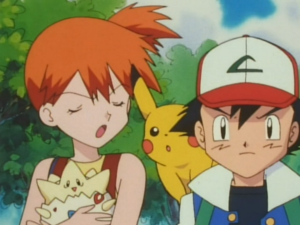
094



Main
Old Updates Archive
Links
 |
Lists |
List of Pokémon
Pokémon World Atlas
List of Techniques
List
of Items
List of TV Episodes
 |
Guides |
Episode
Comparisons
Movies
& Specials Guide
CD Guide
DVD Guide
Voice
Actors Guide
Lyrics Archive
Manga Guide
Video Games
 |
Miscellaneous |
Humor
Pokémon Bashing
Features
Rants
E-Mail Me

Episode Stats:
Japanese Episode 094: "The Gluttonous Kabigon! A Big Panic!"
English Episode 239: "Snack Attack"
Pokémon Dare Da? Kabigon (Japanese), Ivysaur (English)
Dr. Ookido's Pokémon Course: Kusaihana
Japanese Air Date: April 29th, 1999
American Air Date: March 25th, 2000
Important Characters: Nana (Ruby)
Important Places: Seven Zabon Islands (Seven Grapefruit Islands)
Our heroes are
riding along on Laplace one day when they discover that a string of
islands called the the Seven Zabon Islands are nearby. They land on
Zabon Island No. 1 and are about to help themselves to one of the
pummelos growing nearby when they're approached by a young woman named
Nana. She explains that a pummelo thief has been stealing fruit from
the area and so Satoshi and his friends decide to help her stop them.
Before long it's revealed that the pummelo thief is...a wild Kabigon!?
Our heroes try to fight off the glutton with their own Pokémon
but they're no match for its massive size and strength. Kabigon
finishes off all the pummelos on Island No. 1 and so it hops into the
ocean and swims its way to Island No. 2. Satoshi and the others follow
and, once they catch up, try a number of non-violent ways to get
Kabigon to stop. The Rocket trio also appears and try to hypnotize the
Kabigon to sleep, giving Satoshi and his friends the idea to get that
Purin that's always following them around to put it to sleep. They
successfully lure the singing Pokémon out and then wait for its
song to put Kabigon to sleep before Satoshi throws a Monster Ball at it
and gets it. Once everyone wakes up, Nana and the others thank Satoshi
and his friends for all their help as they set off on their next
adventure with their new teammate.
Thoughts
You often see the Orange
Islands described as a "filler arc," a chunk of episodes that only
exist to buy the show time while Game Freak works to finish making Pocket Monsters Gold & Silver.
And while that is objectively true, the term "filler arc" also includes
a connotation that these 36 episodes just don't matter,
that
you're OK to skip over the entire arc because it's just not worth your
time. But then you get to an episode like this, or the one later in the
saga where
Satoshi's Lizardon finally starts to obey him, and you know that this
is also simply not true.
The Kabigon that Satoshi
gets here in the Orange Islands is the same one he'll use to defeat
Ibuki's
Kingdra in his final Johto League Gym Battle. It will go on to defeat
two of
Shigeru's Pokémon and two of Hazuki's
Pokémon in the Shirogane Conference at the end of his journey
through the Johto Region. In Pocket
Monsters Advanced Generation, Satoshi's Kabigon will help its
Trainer earn the Guts Symbol from the Arena Captain
Kogomi in the Kanto Battle Frontier portion of the series. And in Pocket Monsters Diamond & Pearl,
Kabigon is going to help defeat a random Trainer in the Suzuran
Conference. To
dismiss the Orange Islands arc as a mere "filler arc" is to dismiss the
contributions a Pokémon like Kabigon's made to the rest of
Satoshi's journey, and that's kind of messed up.
Something else I really
enjoyed was how, when I was researching this episode, I came across
this realization that oh yeah, Kabigon's addition to the team was
absolutely spoiled by the show's opening theme, wasn't it?

It's something I hadn't ever really realized before but looking back it just seems so, so obvious. Fans in the West weren't able to watch the show as it came out in Japan back in 1999 the way they're able to do now and so all I can do is wonder what it would've been like if we had social media back then. Would fans have seen this capture coming a mile away? And what would their reaction have been?
The script for the
English dub is pretty bad in the first half but improves significantly
in the second half so I'm not really sure what's going on there. Like,
if the whole thing was one massive rewrite, or if the whole thing was
super
faithful to the Japanese original then that'd be one thing. But a weird
half-and-half situation?
Did they have different writers working on different parts of this
episode for some reason? Other than that, we get the usual music edits
(4Kids really doesn't seem to like the music from Pikachu's Summer Vacation, huh?)
and yet another random Victreebel voice tampering, making "Snack
Attack" a really
weird episode all around.
Dialogue
Edit
The name of the island chain in the Japanese version of this episode is
the Seven Zabon
Islands (ザボン七島). The word
zabon (ザボン) translates to "pummelo,"
but the English dub changes this to "grapefruit" for who knows what
reason. To make
things a bit more confusing, the English dub will end up using the word
"pummelo" anyway later on
when they use it for the name of the island that Ash challenges Drake
on during the Orange League finals.

If this was an episode from Generation 3 onwards the fruit in this episode would've just been called Obon ("Sitris") Berries but since those didn't exist yet they ended up using real world fruit instead.
As for the woman who works there, Nana's name comes from the Japanese word for "seven" (七) while "Ruby" comes from ruby red grapefruits.
After the title screen,
our heroes see the fruit:

| Japanese
(original) |
Japanese
(translated) |
English
Dub |
| サトシ 「へー、これがザボンかあ?どれどれ…」 |
Satoshi: "So these are
pummelos, huh? Let's take a look..." |
Ash: "Wow! Just like at the
size of em'! They're humongous!" |
And then, if we jump ahead a little bit:

| Japanese
(original) |
Japanese
(translated) |
English
Dub |
| サトシ 「わかってもらえればいいです」 |
Satoshi: "We're glad you
understand (that we're not thieves)." |
Ash: "I thought they grew by themselves." |
| カスミ 「あたし達こそ勝手にもいでごめんなさい。ザボンを見るのは初めてだか
ら、つい」 |
Kasumi:
"And we're sorry for just picking them like that. It's just that it was
the first time we'd ever seen a pummelo..." |
Misty: "Yeah, we didn't know all these grapefruit belonged to somebody. We should have asked before we picked any." |
The excuse our heroes give Nana for just taking the fruit they come across is that they got carried away since this is the first time they'd ever seen a pummelo before. This is an excuse that would have worked wonderfully as-is in the English dub since most Americans have probably never seen a pummelo before either, right? But! Because the 4Kids dub decided to randomly change "pummelo" to "grapefruit" this dialogue no longer makes sense as-is. So 4Kids just rewrote the line entirely.
Now let's return to the beginning of the episode, to the part right before Ruby tries to bash a child's skull in with a large stick:

| Japanese
(original) |
Japanese
(translated) |
English
Dub |
| ナナ 「泥棒!」 |
Nana: "Thieves!" |
Ruby: "Stop! Thieves!" |
| カスミ 「泥棒⁉」 |
Kasumi: "Did she say thieves?" |
Misty: "Did she say thieves?" |
| ケンジ 「どこだ⁉どこだ⁉」 |
Kenji: "Where!? Where are
they?" |
Tracey: "That's terrible." |
| サトシ 「オレたちが捕まってやるぜ!」 |
Satoshi: "Let's go help catch
them!" |
Ash: "Well, I sure hope she
catches 'em." |
I just love the audacity of this rewrite considering how little the animation here actually fits the new lines 4Kids decided to give them. Why is Tracey looking around frantically when saying "That's terrible?" And what's with the look of determination Ash has on his face? Did 4Kids just write this with their eyes closed or what?
Ruby finishes telling the children about her precious "grapefruit":

| Japanese
(original) |
Japanese
(translated) |
English
Dub |
| ナナ 「だから泥棒にはとてもピンカンになちゃって…」 |
Nana: "And that's why I get
like that with thieves." |
Ruby: "They're almost like my
children so I care about all of them." |
| ケンジ 「そんな苦労が、じゃ無理もないですね」 |
Kenji:
"With how much work you put in I can see why." |
Tracey: "I can see why after
so much work." |
Nana doesn't really seem to have the same maternal instinct over fruit (!!) that her dub counterpart does.
The culprit is found:

| Japanese
(original) |
Japanese
(translated) |
English
Dub |
| ナナ 「どこ⁉どこなの⁉」 |
Nana: "Where!? Where's the
thief!?" |
Ruby: "Where are they?" |
| 男 「あぁ、ナナさん。あそこです」 |
Man:
"Oh it's you, Nana-san. The thief's over there!" |
Man: "Not 'they,' Ruby. 'It'." |
In the Japanese version the word that keeps being used to describe the pummelo thief is dorobou (泥棒). Dorobou, unlike its English counterpart, can be either singular or plural, or neither, depending on the context. The English dub had to pick one or the other -- the English language is less ambiguous about things like that -- and so the plural "thieves" is what they ended up going with. With how quickly the fruit is disappearing it's only natural to assume there'd be more than one person stealing their fruit, right? The rewrite of this worker's line here, accordingly, is an attempt to bridge that gap between the singular and plural versions of the word that the Japanese version just didn't have to deal with.
Ash scans Snorlax with his Pokédex:

| Japanese
(original) |
Japanese
(translated) |
English
Dub |
| ポケモン図鑑 「カビゴン、いねむりポケモン。一日に食べ物を400キロ食べな
いと気がすまない。そして食べ終わると眠ってしまう」 |
Pokémon Bestiary:
"Kabigon, the Sleeping
Pokémon.
It is not satisfied unless it eats 400 kg of food a day. When it
finishes eating it falls asleep." |
Pokédex: "Snorlax, the
Sleeping Pokémon. Snorlax isn't satisfied unless it eats at
least 900 lbs of food per day. Once it is full it promptly goes to
sleep." |
Four hundred kilograms is about 882 pounds and so 4Kids rounded it up to 900.
The children pick a bunch of fruit:

| Japanese
(original) |
Japanese
(translated) |
English
Dub |
| サトシ 「ずいぶん収穫したな」 |
Satoshi: "We sure did gather a
lot." |
Ash: "Hey, they did a really
great job." |
| カスミ 「このザボン、早くナナさんに」 |
Kasumi:
"And now we have to hurry up and get these over to Nana-san." |
Misty: "At least Snorlax won't
get these." |
| サトシ 「あぁ」 |
Satoshi: "Right." |
Ash: "Yeah." |
Kasumi, unlike Misty, knows that just removing the fruit from the trees won't be enough to stop Kabigon and that they have to actually hand it over to the adult in charge there for any of this to matter. Misty, meanwhile, seems to think that her work here is done...?
The next few edits I'll bring up all involve 4Kids adding in some idioms / play on words that undoubtedly gave headaches to the localizers who rely on this version of the show overseas. Snorlax starts to eye the next island over:

| Japanese
(original) |
Japanese
(translated) |
English
Dub |
| サトシ 「カビゴン、ジャンプして隣の島へ行こうというのか?」 |
Satoshi: "That Kabigon isn't
going to try to jump over to the next island, is it?" |
Ash: "Do you think Snorlax is
getting ready to fly to
another island?" |
| カスミ 「無理無理!カビゴンは空を飛べないんだから」 |
Kasumi: "No way! Kabigon can't
soar through the air like that." |
Misty: "Not unless it has a
ticket on a jumbo jet." |
| トゲピー 「チョゲチョゲ」 |
Togepy: "Toge Toge!" |
Togepi: "Toge Toge" |
Kasumi's comment about Kabigon being unable to soar through the air gets replaced with a fat joke.

| Japanese
(original) |
Japanese
(translated) |
English
Dub |
| カスミ 「カビゴンって泳げんの?」 |
Kasumi: "Kabigon can swim!?" |
Misty: "I didn't know Snorlax
could swim." |
| サトシ 「しかもバッタフライだぜ!」 |
Satoshi: "And it's doing the
butterfly at that!" |
Ash: "It's doing the
blubberfly!" |
Satoshi's comment about Kabigon doing the butterfly gets replaced with a fat joke.

| Japanese
(original) |
Japanese
(translated) |
English
Dub |
| ケンジ 「そうか!カビゴンは泳いでここに来たんだ。ん。これでなぜこの島にカ
ビゴンがいたのか、謎が解けた」 |
Kenji: "I see! Kabigon swam
its way over here! Hmm...the mystery of why a Kabigon was on this
island in the first place has been solved!" |
Tracey:
"Of course! I should have figured it was a good swimmer. That solves
the mystery of how Snorlax got to the island in the first place." |
| カスミ 「謎が解けたからって喜んでられないでしょう」 |
Kasumi: "Solving that mystery
doesn't mean we can celebrate just yet." |
Misty: "We'd better figure out
a way to keep it from getting to the second place." |
No added fat joke this time around; instead, 4Kids plays around with the phrases "in the first place" and "in the second place" in a way that wasn't possible in the Japanese original.
The thing about these three rewrites -- "jumbo jet," "blubberfly," and "second place" -- is that while they work perfectly fine in English they only serve to introduce headaches for the poor staff whose job it is to localize this version of the show into other languages. How did the German team handle the "blubberfly" joke? What kind of joke did Spanish speakers get in place of the "jumbo jet" one? Did the Italian dubbers get the "first place" / "second place" play on words?
Team Rocket tries to eat the "grapefruit":

| Japanese
(original) |
Japanese
(translated) |
English
Dub |
| ニャース 「見わたすかぎりザボンだニャ!これを放っておく手はないニャ」 |
Nyarth: "Pummelos as far as
the eye can see Nya! No way we can leave them behind Nya." |
Meowth: "It's rainin' Vitamin
C! And we could sure use some these days." |
| コジロウ 「なんせこのごろは食費にも事欠いているし」 |
Kojirou: "And besides, we
haven't had enough money for food lately." |
James: "Luckily, we found a
source of free nutrition." |
| ムサシ 「つまってるつまってる!」 |
Musashi: "It sounds like it's
ripe." |
Jessie: "(chuckles) Thin skin." |
| コジロウ 「スイカじゃないんだから」 |
Kojirou: "That only works on
watermelons, not pummelos..." |
James: "Just like you have, Jess." |
| (shoves
fruit in her teammate's mouth) |
||
| ムサシ 「いいんじゃないのよー!」 |
Musashi: "Same difference,
right!?" |
Jessie: "..." |
Team Rocket's dialogue in the 4Kids version is usually rewritten in the sense that "we'll still give you the general gist of what's being said but we're still going to have them say pretty much whatever the hell we want." So these first two lines aren't all that surprising. But then we get to the "thin skin" part which is 100% a rewrite. Does Kojirou's face in the screenshot above look like the face of someone who's insulting his teammate?
Anyway, Jessie claims the grapefruit is "thin skinned" and then in literally the very next scene we see Meowth break his hand trying to claw one open so *shrugs*
James talks about what good these "grapefruits" are for:

| Japanese
(original) |
Japanese
(translated) |
English
Dub |
| コジロウ 「確かザボンは実を食べるんじゃなかったと思うけど」 |
Kojirou: "Now that I think
about it, I don't think you're supposed to eat pummelo flesh." |
James: "Maybe this type of
grapefruit isn't grown for its fruit." |
| ニャース 「実を食べないでどこ食べるんだニャ」 |
Nyarth: "If you don't eat the
fruit then what do you eat?" |
Meowth: "Well if you don't eat
the fruit, what do you eat?" |
| コジロウ 「昔じいやがおやつにザボンの皮の砂糖づけを持ってきたような気
が…」 |
Kojirou: "I seem to recall the
old handyman at my place giving me pummelo peels coated in sugar as a
treat..." |
James: "I seem to recall the
servants giving me candied grapefruit peels as a child." |
| ムサシ 「おぉおぉ!さすがお坊ちゃま~」 |
Musashi: "Wow! You really were
a spoiled young man, weren't you?" |
Jessie: "Servants! That
must've been the life." |
| ニャース 「でもニャたちは砂糖をもってないニャ」 |
Nyarth: "But we don't have any
sugar on us Nya." |
Meowth: "You mean...we gotta
turn the peels into candy?" |
The word Kojirou uses to describe the person who gave him the candied pummelo peels -- jiiya -- is the exact same phrase used to describe the old man in the Pocket Monsters Advanced Generation episode where he trades out his Chirean for a Manene.

Now is this meant to be a reference to an episode of the TV show that won't air for another six years? Probably not. The word jiiya is a fairly generic term that means "elderly handyman" or "elderly manservant" and therefore doesn't really denote any one person in particular. So for all we know Kojirou's estate had a number of jiiya employed and the one we see in that one Advanced Generation episode is just one of many!
Oh, and also 4Kids? You can absolutely eat grapefruit fruit.
Eyecatch
Kabigon vs. Ivysaur.
 |
 |
Once again we get some unique artwork in the Japanese eyecatch that dub viewers just never get to see.
Dialogue Edit
Arbok vs. Snorlax does not end well for Team Rocket:

| Japanese
(original) |
Japanese
(translated) |
English
Dub |
| ニャース 「ヘビ皮の財布がたくさんできるニャー」 |
Nyarth: "We could make a bunch
of snakeskin wallets Nyaow..." |
Meowth: "Arbok looks like a snakeskin belt." |
| コジロウ
「入れるお金がないって」 |
Kojirou: "We don't have any
money to put in them though..." |
James: "Big enough to fit Snorlax!" |
The idea of skinning the corpse of Musashi's Pokémon and using it to make an accessory for humans to use is present in both versions but the accessory in question is a bit different.
Either way, this out-of-character reference to a real world animal -- in this case, a snake -- is present in both versions.
Jessie calls out her next Pokémon to attack:

| Japanese
(original) |
Japanese
(translated) |
English
Dub |
| ムサシ 「次、行けベロリンガ!」 |
Musashi: "You're up next,
Beroringa!" |
Jessie: "Lickitung! It's Wrap
time!" |
Jessie's revelation that her Lickitung can use Wrap attack is dub only; in the original she only issues a generic battle command.
James' Victreebel -- who, for some reason, gets its voice altered for the dub of this episode -- gets flattened by Snorlax:

| Japanese
(original) |
Japanese
(translated) |
English
Dub |
| コジロウ 「は~。俺のウツボットは押し花じゃない~」 |
Kojirou: "Ah~ My Utsubot's not
some kind of pressed flower art!" |
James: "My Victreebel looks
all rung out!" |
"Pressed flower art" -- oshibana (押し花) in Japanese -- is a traditional Japanese art form where you take dried up flower petals, leaves, stems etc. and press them onto paper using a specialized machine in order to create unique artwork. It's a traditional Japanese artform that's known worldwide but I suppose 4Kids thought it would've been too obscure for their target audience and so they rewrote it.
Ash and his friends try to massage the Snorlax asleep:

| Japanese
(original) |
Japanese
(translated) |
English
Dub |
| サトシ 「お客さん、こってるねー」 |
Satoshi: "Well there sir, you
sure have a lot of tension built up." |
Ash: "Let the tension flow
away!" |
| カスミ 「どちらからいらしたのー?」 |
Kasumi: "And where did you
come
in from today?" |
Misty: "Just relax, Snorlax." |
Satoshi and Kasumi are doing this bit where they're acting like they're employees at a hot springs massage parlor while Ash and Misty are just talking to Snorlax as themselves.
The script for the other attempts are all actually pretty decent. There are some number changes with Misty's counting segment (in Japanese she falls asleep when she reaches 89 while in English she finishes at 99) and the Rocket trio's singing is way more (purposefully) terrible in Japanese but otherwise it's pretty solid!
The next dialogue change doesn't happen until the very end of the episode where Ruby explains Snoarlax's special power:

| Japanese
(original) |
Japanese
(translated) |
English
Dub |
| ナナ 「すごい生命力!これなら大きいな木になりそうね」 |
Nana: "What an incredible life
force! These are sure to grow into huge trees." |
Ruby: "This is amazing! I've
never seen anything like this before." |
| ケンジ 「もしかしたらカビゴンには植物を育てる力があるのかもしれませんね」 |
Kenji: "I wonder if Kabigon
has some kind of special ability to raise plants or something." |
Tracey: "Maybe Snorlax has
some kind of special ability that helps the trees grow back again." |
| カスミ 「そうよね。あれだけ食べるんだから、そういう力もありそうよね」 |
Kasumi: "I think you might be
right. If it can eat that
much then it probably has some kind of life giving power as
well." |
Misty: "Whatever it is, I
guess it proves something good can come out of something bad." |
| ナナ 「来年は豊作よ!ここはまたザボンでいっぱいになるわ」 |
Nana: "Next year should be a
good harvest! This place'll be filled with pummelo fruit again!" |
Ruby: "I think you're right,
Misty! Next year we may have more fruit that ever!" |
| サトシ 「良かったね、ナナさん」 |
Satoshi: "I'm so happy for
you, Nana-san." |
Ash: "I hope so, Ruby!" |
The part I want to point out is Kasumi's line, where originally she reasons that Kabigon being a bottomless pit could have something to do with its power to make plants bloom. We don't get that kind of theory in the English dub, though!
Finally, the narrator takes us out:

| Japanese
(original) |
Japanese
(translated) |
English
Dub |
| ナレーション 「なんとかカビゴンの大食いを止め島のザボンを守ったサトシた
ち。彼らのオレンジ諸島の旅はまだまだ続く」 |
Narrator: "Somehow, Satoshi
and his friends were able to stop Kabigon's feeding frenzy and protect
the
islands' pummelos. And so their Orange Islands journey continues." |
Narrator: "And so, as the sun
slowly sets like a giant glowing grapefruit our heroes sail on to their
next Orange Island adventure." |
The dub makes no mention of Snorlax or its gluttony the way the Japanese version does.
| Previous Episode |
This page was last updated on March 28th, 2022
Found an error or omission? Please help me keep this page current and error-free by e-mailing me with a description of the issue.

